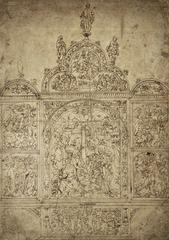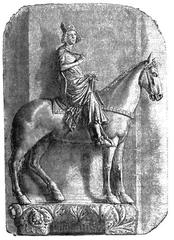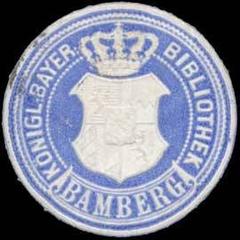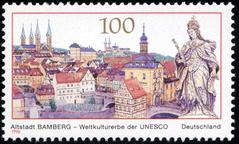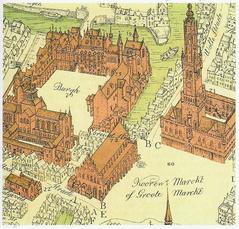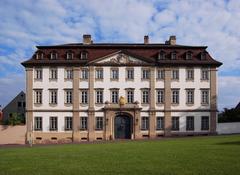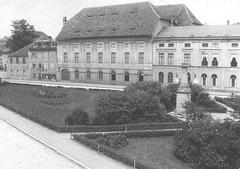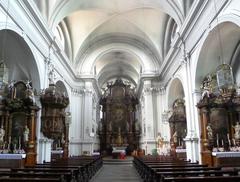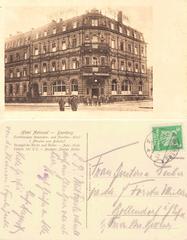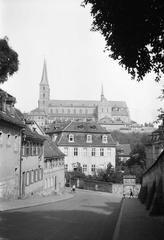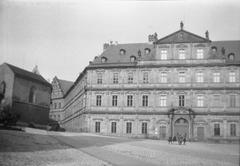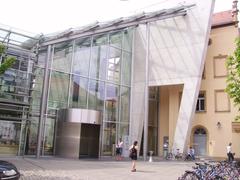
Drudenhaus Bamberg: Visiting Hours, Tickets, and Historical Sites Guide
Date: 04/07/2025
Introduction: The Drudenhaus and Its Historical Legacy
In the heart of Bamberg, Germany, the Drudenhaus stands as a symbol of the city’s darkest period—the Bamberg witch trials of the early 17th century. Commissioned in 1627 by Prince-Bishop Johann Georg II Fuchs von Dornheim, this prison, also known as the Malefizhaus or Hexengefängnis, was the principal site for the incarceration and interrogation of alleged witches. Although the Drudenhaus itself was demolished in the mid-17th century, its legacy endures through memorials, museum exhibits, and educational programs that invite visitors to reflect on the tragic consequences of mass hysteria and judicial abuse (Wikiwand; Bamberg Regio; Solitary Watch).
This guide offers a detailed overview of the Drudenhaus’s historical significance, practical information for visitors, and recommendations for exploring related sites in Bamberg’s UNESCO World Heritage old town. Whether you are a history enthusiast, a cultural traveler, or a student of human rights, this comprehensive resource will help you engage meaningfully with Bamberg’s compelling past.
Table of Contents
- Introduction
- Origins and Construction of the Drudenhaus
- The Bamberg Witch Trials: Historical Context
- What Remains Today: Memorials and Interpretation
- Visiting Hours, Ticket Information, and Accessibility
- Guided Tours and Special Events
- Nearby Attractions and Suggested Itinerary
- Practical Visitor Tips
- Educational Value and Contemporary Relevance
- Frequently Asked Questions (FAQ)
- Conclusion and Call to Action
- Sources
Origins and Construction of the Drudenhaus
The Drudenhaus was constructed in 1627 at the behest of Prince-Bishop Johann Georg II Fuchs von Dornheim, amidst a wave of witch hunts that swept the region. Bamberg, then a prince-bishopric with around 12,000 inhabitants, became infamous for the severity of its witch persecutions. The prison was purpose-built, containing 26 individual cells and two larger communal cells, as well as a torture chamber known as the “Peinliche Frag” (Wikiwand; RouteYou). An inscription above the entrance, drawn from Virgil’s Aeneid—“DISCITE JUSTITIAM MONITI, ET NON TEMNERE DIVOS” (“Let this be a warning to you, learn justice and do not despise the gods”)—underscored the institution’s chilling purpose.
The Drudenhaus was the largest such prison in the region, surpassing similar facilities in Zeil am Main, Hallstadt, and Kronach (Solitary Watch). Its very name, referencing the “Drude,” a supernatural figure in German folklore, reflected the superstitions that sustained the witch hunts.
The Bamberg Witch Trials: Historical Context
Between 1595 and 1631, Bamberg became the epicenter of some of Europe’s most notorious witch trials. Under Prince-Bishop Dornheim’s leadership, at least 880 people—and possibly over 1,000—were executed, representing nearly 1% of the city’s population during the peak years (Bamberg Regio; Solitary Watch). Men, women, and even children were imprisoned and tortured in the Drudenhaus, fueling a cycle of fear, denunciation, and execution.
The trials ended in 1632 during the Thirty Years’ War, when Swedish forces approached Bamberg. Prisoners were abruptly released, the building soon fell into disuse, and by 1635 the Drudenhaus was demolished. Its location is now marked by modern structures, but the memory of its horrors remains.
What Remains Today: Memorials and Interpretation
Though the Drudenhaus building no longer exists, its site—near Geyerswörthstraße and Franz-Ludwig-Straße in Bamberg’s old town—is marked by commemorative plaques and interpretive signage. Visitors can learn about the building’s history and the witch trials through these memorials, as well as through exhibitions at the Bamberg Historical Museum and thematic guided tours (UNESCO World Heritage; Bamberg Tourism).
The absence of the physical structure transforms the site into a place of remembrance, inviting reflection on the lessons of history in the midst of Bamberg’s picturesque urban landscape.
Visiting Hours, Ticket Information, and Accessibility
Drudenhaus Site
- Access: The Drudenhaus site is an open-air memorial, accessible at any time, year-round, with no entry fee.
- Plaques and Signage: Interpretive information is available in German and, increasingly, English.
Related Museums and Exhibitions
- Bamberg Historical Museum (Historisches Museum Bamberg):
- Hours: Tuesday to Sunday, 10:00 AM – 5:00 PM
- Admission: Approx. €5 for adults; discounts for students and seniors (Historisches Museum Bamberg)
- Guided Tours: Thematic tours focusing on the witch trials and Drudenhaus are available through local operators and the Bamberg Tourist Information Office. Advance booking is recommended, especially for tours in English.
- Typical Prices: €10–€20 per person.
Accessibility
The Drudenhaus site and most related museums are wheelchair accessible, situated on paved, pedestrian-friendly streets within Bamberg’s old town. Some cobblestone areas may be challenging for mobility aids; contact the Bamberg Tourist Information Office for detailed accessibility guidance.
Guided Tours and Special Events
Guided walking tours explore Bamberg’s witch trials and the role of the Drudenhaus, providing historical context and personal stories. Many tours are available in English and other languages. Seasonal events—such as lectures, reenactments, and educational workshops—are held around Halloween and during local heritage festivals. Digital resources, including augmented reality apps and virtual tours, are available via official tourism platforms (Bamberg Tourism).
Nearby Attractions and Suggested Itinerary
Bamberg’s old town, a UNESCO World Heritage Site, offers a wealth of attractions within walking distance of the Drudenhaus memorial:
- Bamberg Cathedral (Bamberger Dom): Romanesque and Gothic architecture.
- Old Court (Alte Hofhaltung): Former bishop’s residence.
- New Residence (Neue Residenz): Baroque palace with rose gardens.
- Old Town Hall (Altes Rathaus): Iconic half-timbered structure on the river.
- Geyerswörth Palace: Renaissance palace near the Drudenhaus site.
- Little Venice: Picturesque riverside district.
Suggested Itinerary:
- Morning: Bamberg Cathedral and Old Court
- Midday: Historical Museum and Drudenhaus site
- Afternoon: New Residence and rose garden
- Evening: Stroll through Old Town and enjoy Franconian cuisine
Practical Visitor Tips
- Best Time to Visit: Late spring (May–June) and early autumn (September–October) offer pleasant weather and manageable crowds.
- Language: Most museums and tours provide information in German and English.
- Photography: The site and surrounding streets are ideal for photography; please be respectful of the location’s historical significance.
- Getting There: Bamberg is accessible by train from major German cities. The old town is compact and best explored on foot.
Educational Value and Contemporary Relevance
The Drudenhaus is central to discussions about scapegoating, the abuse of judicial power, and the necessity of due process. Its story is used in schools, museums, and public commemorations to promote tolerance, justice, and historical awareness (Bamberg Regio; Solitary Watch).
Frequently Asked Questions (FAQ)
Q: Can I visit the original Drudenhaus building?
A: The original building was demolished in the 17th century. Visitors can explore the marked site and related museum exhibits.
Q: Are there guided tours about the Drudenhaus and witch trials?
A: Yes, guided walking tours are available through local operators and the Bamberg Tourist Information Office. English-language tours are offered, especially during tourist seasons.
Q: Is there an entry fee?
A: The memorial site is free to visit. Museum exhibits and guided tours may require tickets.
Q: Is the site accessible for people with disabilities?
A: Yes, the site is on paved streets and most museums are wheelchair accessible, though some cobblestone areas may be challenging.
Q: What digital resources are available?
A: Augmented reality apps and virtual tours are offered by local museums and the tourism office.
Conclusion and Call to Action
The Drudenhaus is an essential part of Bamberg’s rich and complex heritage. Visiting the site and participating in guided tours or museum exhibitions enables travelers to reflect on the lessons of history and honor the victims of intolerance. To stay informed about current events, tours, and educational resources, consult official Bamberg tourism channels and download the Audiala app for guided audio tours and insider tips.
Respect the site’s solemn legacy and help keep the memory of the Bamberg witch trials alive for future generations. Plan your visit today and deepen your understanding of European history in this remarkable city.


